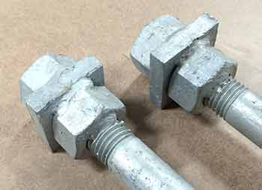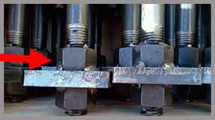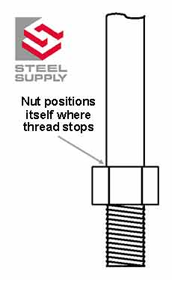We have recently seen an increased focus on the topic of anchor bolts and threading. In a previous blog entry, we discussed considering the thread length of Anchor Bolts with excess thread on the exposed end. Based on the intentions and needs of particular steel fabricators, this topic may or may not be applicable to your business (of course, we’ll manufacture the Anchor Bolts to any specification required.)
However, there is also a situation under the “anchor bolt umbrella” that we run into frequently, and it always leads to follow-up questions and further exploration: a straight Anchor Bolt with excess thread on the embedded end and the hardware welded in place.

The photo example above shows the embedded end of two Anchor Bolts. The Anchor Bolts in this case are 1” diameter. The drawing calls for:
- Heavy Hex Nut on the upward side
- Plate Washer 1/2” thick
- Another Heavy Hex Nut on the downward side
The plan requires the nuts to be wrench tightened. Then, both nuts need to be welded to the round bar, and both nuts welded to the plate washer. So, once either nut is welded into place, the extra thread above the upward nut cannot be used.
The extra thread raises two issues. The obvious one is the extra time that the threading takes. While it could be a minimal 10 seconds, orders are often for significant quantities. If this order was for 200 Anchor Bolts, the extra thread adds over 30 minutes of machine time.

The second issue is plate washer placement. All plans should come with a specific location (depth) for the plate washer. This is important for two reasons:
- The deeper the plate washer, the greater it expands the area of concrete that will resist any uplift. This is known as the “Pull-Out Cone.”
- The Anchor Bolt and Plate Washer have to co-exist with a rebar plan. It is important to stay within the space the designer allocated.

By including an extra length of thread, the designer has created a variable that appears unnecessary. All the Heavy Hex Nuts shown in both photos are wound on by hand. With the extra thread, the installer takes time to position the upward nut so it will hold the Plate Washer at the correct depth.
The photo above shows how the position of the upward nut impacts the Plate washer positioning. The plate washer can be set at a specific depth by coordinating the thread to a length that will consistently provide that depth with no attention by the installer.
Often, our instruction for our Steel Fabricating customers is to follow the plan as shown. Of course, we will always adhere to our customers’ instruction. When possible, threading as shown in this blog will save threading time, placement time and removed the possibility for error.
One noteworthy point is the Plate Washer dimensions in the first photo – both thickness and length x width. The 1/2” thickness is heavy for a 1” diameter Anchor Bolt. They are usually specified at 1/4” or 3/8” thick. Also, at 2” x 2” the Plate Washer is smaller than we usually see. Its span only exceeds the Heavy Hex Nut by 3/16” flat to flat, and 1/16” from corner to corner. This could be for a variety of reasons. This plan called for F1554 Grade 55 S-1 Round Bar, instead of the typical A-36. That indicates a desire for greater tensile and yield strength. That may explain the 1/2” thickness. The 2” length x 2” width could indicate the need to fit into a tight rebar plan that did not allow for a lot of clearance.
Again, as the Anchor Bolt manufacturer our role is to produce bolts in whatever configuration the plan calls for.
Ordering Anchor Bolts
If you are in request of anchor bolts, connect with The Steel Supply Company. Our anchor bolts are manufactured at our West Babylon, NY facility, and our extensive round bar stock allows for fast delivery to keep all of your projects on schedule. To get a quote, call 631-385-7273 or click the link below for more information.





